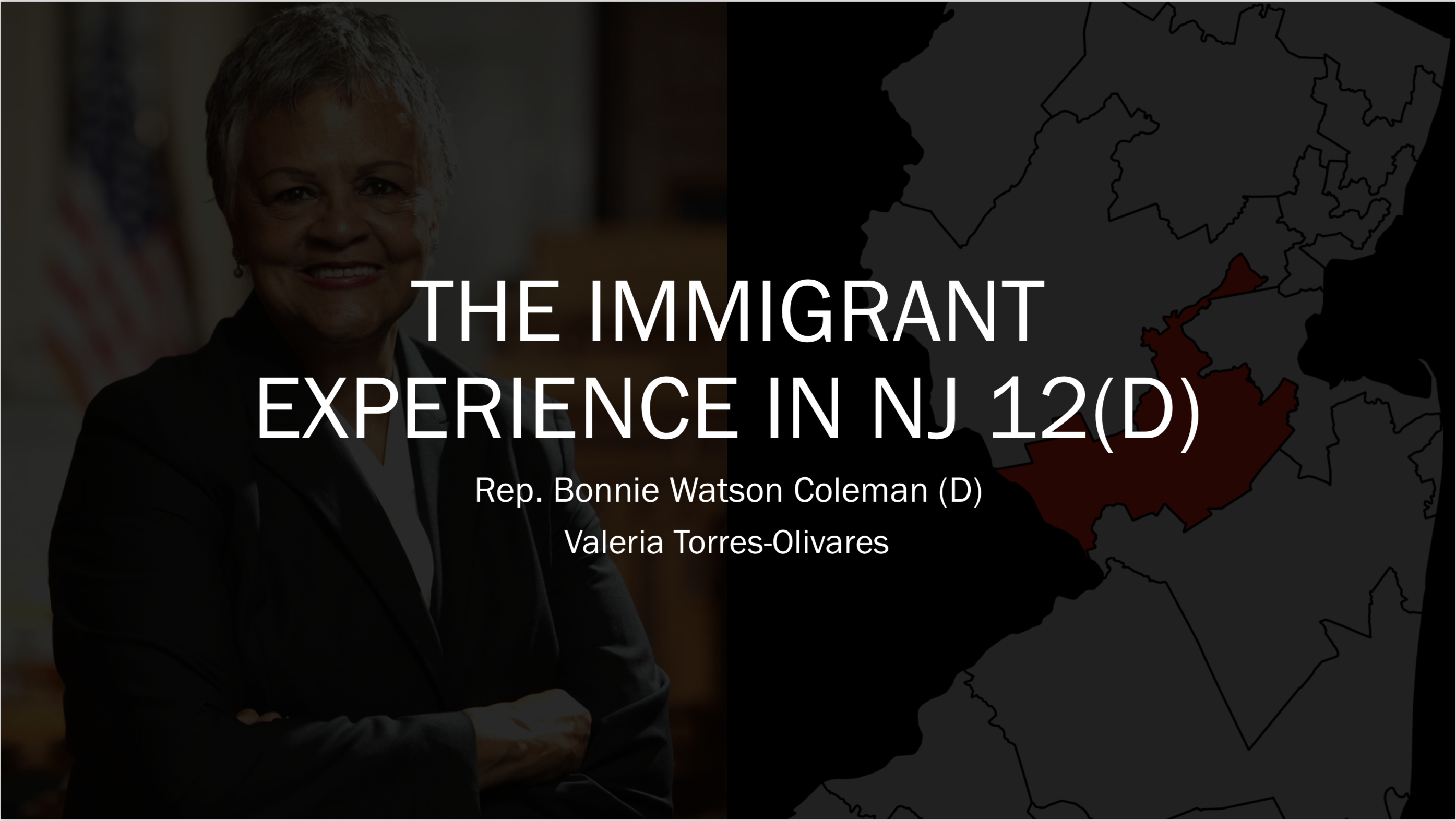
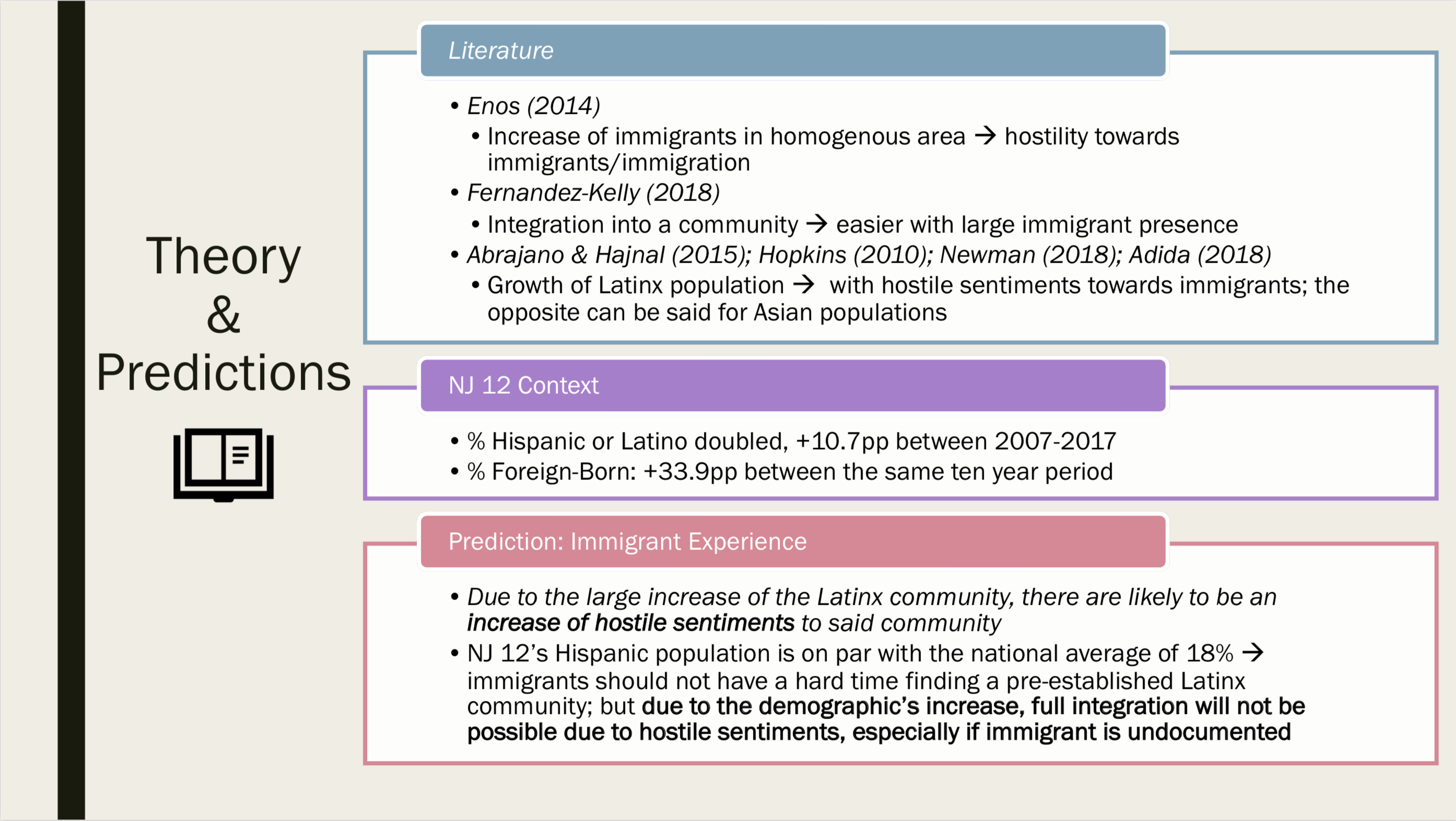
Slide 1: In Enos’ “Causal effect of intergroup contact on exclusionary attitudes,” the author talks about the immigrant community at large and the correlation between the increase of immigrants in homogenous areas and how that leads to hostility and negative sentiments towards immigrants. The fact that the rapid growth of the Latinx population in an area correlates with an increase in negative sentiments towards immigrants and immigration is also talked about by Abrajano & Hajnal (2015); Hopkins (2010); Newman (2018); Adida (2018). Patricia Fernandez-Kelly’s paper called “The Integration Paradox: Coping Strategies among Immigrant Children in the Age of Mass Deportations,” talks about how integration of immigrants in a community is easier if there is already a pre-existing large presence of immigrants within said community. However, this is not true when it comes to Asian immigrants and their political representation, which was examined by Aptekar’s paper which is titled “Highly Skilled but Unwelcome in Politics: Asian Indians and Chinese in a New Jersey Suburb.” When looking at NJ 12, data from the United States Census Bureau shows that the Latinx population of NJ 12 more than doubles from 2007 to 2017 (going from 7.4% to 18.1%). In addition to this, another large demographic shift was seen in the number of foreign-born residents in the district. In 2007 the foreign-born pop. was 13.4%, which then increased to 44.3% in 2017, indicating a +30.9pp. Based on the existing literature on demographic shifts of immigrants (specifically Latinos), the increase of the Latinx community in NJ 12 means that it is likely for there to be an increase of hostile sentiments to the immigrant and Latinx community. As a result of NJ12’s Latinx population increase, it is now on par with the national average of 18% Hispanic. This means that Latinx immigrants should in theorynot have too much of a hard time “integrating” into communities within NJ 12; however, in reality I predict that this is not the case and that integration is not easy, especially for those immigrants that are undocumented.
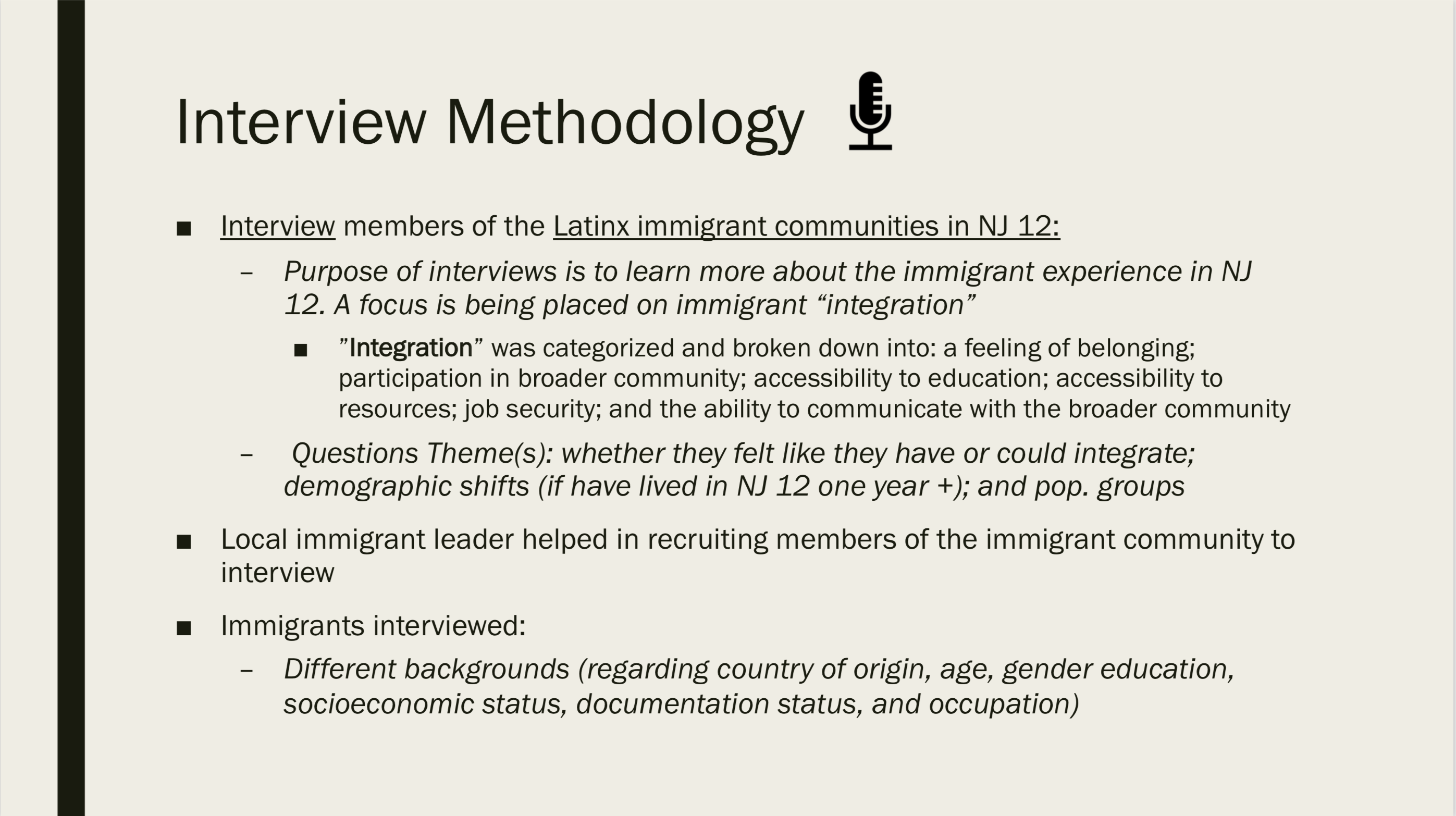
Slide 2: In order to test my prediction about the immigrant experience I needed to break down what “integration” means. I defined “integration” into categories: feeling of belonging; participation in broader community; accessibility to education; accessibility to resources; job security; and the ability to communicate with the broader community. In order to find out if the prediction for NJ12 was true or not, the interviewing of immigrants was conducted, this included undocumented immigrants. The interviews would be focused on members of the Latinx immigrant community. The questions being asked of them would revolve around what I previously defined as being integrated into the community, and whether they felt like they could or have integrated. Questions about population groups were asked as well, and for those who have lived in NJ12 for a year or more were also asked whether or not they have noticed a demographic shift within those groups. Since all of those interviewed were immigrants, data in order to contextualize their responses was also collected (ex: age, country of origin, length of time in the community, employment, how they ended up in that community, etc.,). A total of five immigrants were interviewed. They ranged in gender, age, occupation, country of origin, documentation status, and length of time within NJ12. In terms of getting in touch with the immigrants interviewed, I reached out to a local leader from the immigrant community to help me get the interviews of these immigrants.
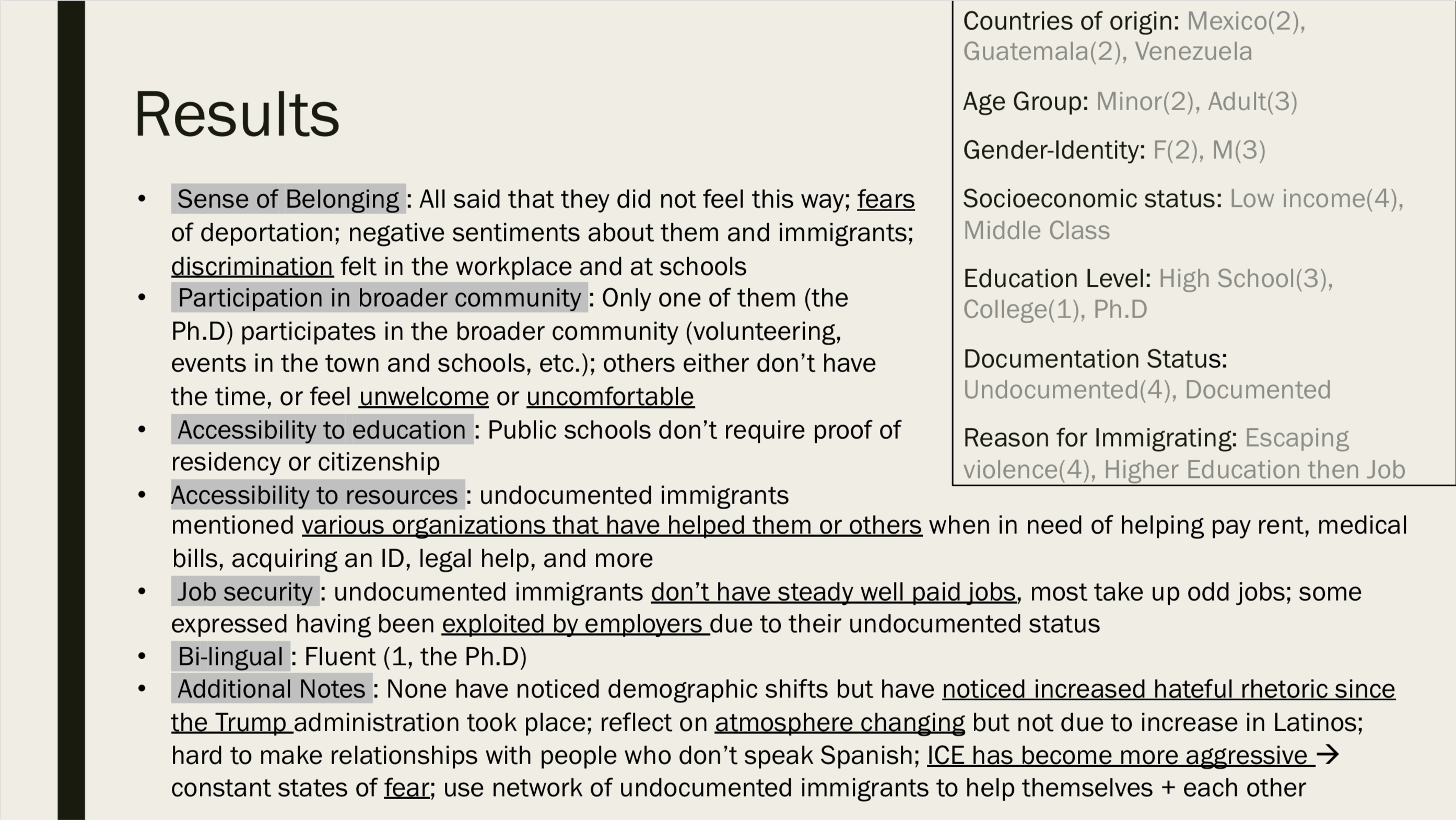
Slide 3: In order to put the responses of the interviewee’s I will go over some of their information to add context: Countries of origin: Mexico(2), Guatemala(2), Venezuela; Age Group: Minor(2), Adult(3); Gender-Identity: F(2), M(3); Socioeconomic status: Low income(4), Middle Class; Education Level: High School(3), College(1), Ph.D.; Documentation Status: Undocumented(4), Documented; Reason for Immigrating: Escaping violence(4), Higher Education then Job. In order to get a sense of the immigrant experience in NJ 12, I focused mostly around the “integration” of the immigrant. In the previous slide I defined “integration” into categories: feeling of belonging; participation in broader community; accessibility to education; accessibility to resources; job security; and the ability to communicate with the broader community. When asking the immigrants if they had a sense of belonging in NJ 12, all of them answered no. This sentiment is specially seen in the undocumented immigrants of whom I interviewed; the reason for this being mainly attributed to the fear of deportation they face on a daily basis. While ICE raids are not necessarily frequent in the area, according to all of them, ICE has become more aggressive and has even targeted parents when dropping their kids off at school. For example, just last week there were three undocumented immigrants detained and taken from their homes, all parents, leaving their families without a much-needed provider. Another reason why a sense of belonging is absent for all of the interviewees is that they all have experienced negative rhetoric towards them and those they know as immigrants, including their kids while at school. As a result of the lack of belonging and the fact that many of those interviewed work multiple jobs and are students, they do not participate in the broader community. The only one of those I interviewed who participates in the broader community is the immigrant with a Ph.D., through volunteering and attending events in the schools and town. Others do not have the time and feel unwelcome or uncomfortable in those spaces. One great thing about the public schools in NJ 12, is that students do not need to demonstrate citizenship or residency in order to get an education. In addition to this, there are many organizations (as well as some underground) which help undocumented immigrants when in need of helping pay rent, medical bills, acquiring an ID, legal help, and more. One major concern for these undocumented immigrants is being exploited by their employers because of their status. Many of them work unsteady and underpaid jobs, with the exception of the immigrant with the Ph.D. Another barrier to integration is the language barrier, which takes time to overcome especially because of the fact that most immigrants stay within their small communities and do not get immersed in English. It is also hard to make relationships with people who don’t speak Spanish for them. While none of the interviewees noticed the demographic shifts, they have noticed the increased hateful rhetoric since the Trump administration took place. Some reflected on the atmosphere changing but not due to increase in Latinos.
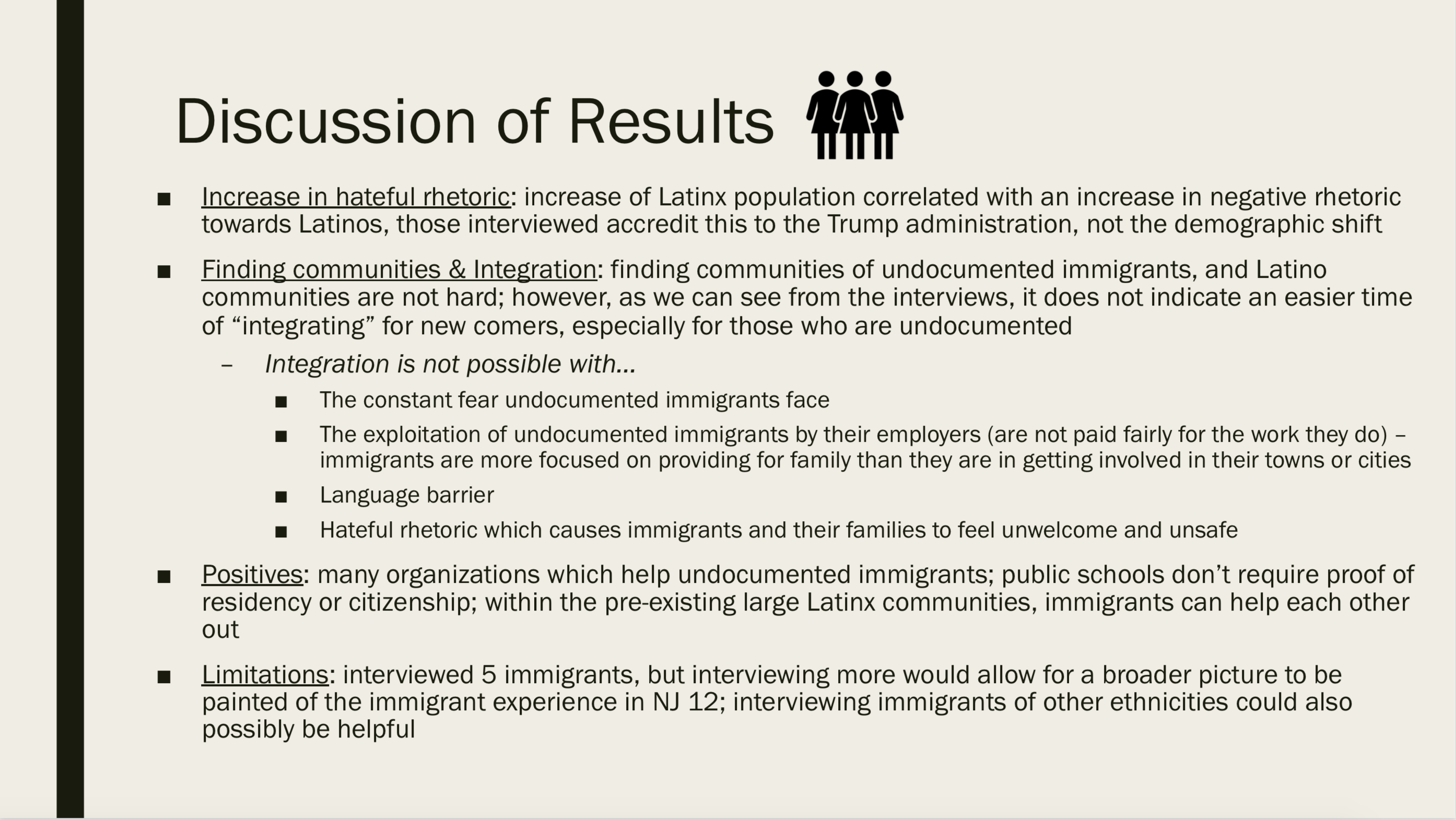
Slide 4: After listening to the five immigrants I interviewed, from what they said, theincrease of Latinx population correlated with an increase in negative rhetoric towards Latinos, but it was the rise of the Trump administration that lead to this, not the demographic shift seen from 2007 to 2017. Findingcommunities of undocumented immigrants, and Latino communities are not hard; however, as we can see from the interviews, it does not indicate an easier time of “integrating” for new comers, especially for those who are undocumented. It seems that integration is not possible with the constant fear undocumented immigrants face, the exploitation of undocumented immigrants by their employers, the language barrier, and hateful rhetoric which causes immigrants and their families to feel unwelcome and unsafe. In addition to this, it is hard for immigrants to be involved in their greater communities since they work long hours, are underpaid, and again, are exploited if undocumented. Some positives that I found in the immigrant experience in NJ 12, reflected by the interviews was the fact that there are many organizations which help undocumented immigrants, access to public schools, and that within the pre-existing large Latinx communities, immigrants can help each other out. Some limitations that I ran into was that while I could only interview 5 immigrants, interviewing more would allow for a broader picture to be painted of the immigrant experience in NJ 12. In addition to this, interviewing immigrants of other ethnicities could also possibly be helpful in terms of grasping a better picture of what the immigrant experience is in NJ 12; however this could make the research less focused.